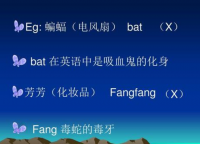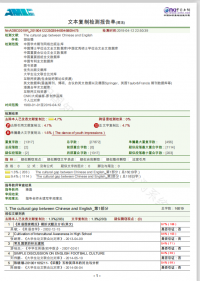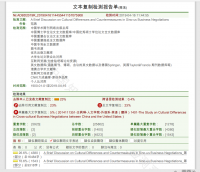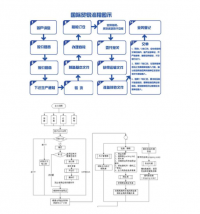论北方方言对英语语音学习的影响和方案
摘要:当今社会,英语是重要的国际通用语言之一,也是世界上最广泛使用的语言。因为地域和母语的不同,中国人学习英语语音存在着挑战,特别是英语发音方面。地区方言对英语语音的学习有着重大的影响,产生了语言的负迁移现象。不同方言背景的学生会产生不同的语音偏误。本文以北方方言为例,针对方言影响下英汉语音发音混淆,发音不准,前后鼻音不分等发音问题,分析原因,并提出了应对策略。
关键词:北方方言;英语语音;发音问题;语言迁移;应对策略
Influence of Northern Dialects on English Phonetics Learning and Countermeasures
Abstract: In today’s society, English has become one of the most important international languages, and the most widely used language in the world. Because of the difference of the region and the mother tongue, there are troubles for Chinese to learn English phonetics, especially with regard to English pronunciation. Regional dialects have a great effect on the study of English phonetics, which results in the phenomenon of negative transfer of language. Students with different dialect background may make different phonetic mistakes. Taking the northern dialect as an example,this paper analyses the causes of the problems under the influence of northern dialects, such as the confusion of Chinese and English pronunciation, inaccurate pronunciation, the mix of front and back nasals, and a series of pronunciation problems, and provides some countermeasures.
Key words: Northern dialects; English pronunciation; Phonetic problems; Language migration; Countermeasures
Contents
1 Introduction 1
1.1 Characteristics of Northern Dialect 1
1.2 Migration Theory 3
2 Comparison of the Pronunciation of Mandarin and English 4
2.1 The Pronunciation of Mandarin 4
2.2 The Pronunciation of English 4
2.3 Comparison between Chinese and English Pronunciation and Intonation 5
3 Negative Transfer Effects of Northern Dialects on English Phonetics Learning 6
3.1 The Influence of Northern Dialects on the Learning of English Vowels 6
3.2 The Influence of Northern Dialects on the Learning of English Consonants 9
3.3 The Influence of Northern Dialects on the Learning of English Intonation 10
4 Strategies for Students in Northern China to Learn English Phonetics 11
5 Conclusion 12
1Introduction
English has become the international language, many countries regard English as an important foreign language, and China is no exception. In China’s education system, English has been incorporated into students’ teaching contents and become a required course. When the Chinese learn to speak, they are exposed to dialects or mandarin, which have gradually become the basic phonetics of Chinese people. In China, many teachers and educators only pay attention to the students’ scores, and do not care whether their pronunciations are standard or not. Students usually do not practice speaking in English so that the students’ English has become dumb English. They have a strong local accent,which has a great effect on their pronunciation. Many college students have passed various types of important English tests, but when communicating with foreign students from English-speaking countries, they have serious communication barriers so they cannot use English they have learned in school to communicate and talk with them. Many English teachers and professors suggest that students should say English bravely when they have opportunities to speak it. When students speak English bravely, teachers can help them find mistakes and correct their wrong pronunciation. In the process of learning English, correcting the wrong pronunciation is very important and should become a good habit. The accuracy of English pronunciation has a direct impact on listening and speaking in communication. If the pronunciation is not accurate, it may cause listener’s unnecessary misunderstanding. Therefore, students should speak Standard English to make others understand the meaning when talking with them.
1.1 Characteristics of Northern Dialect
A dialect is a variant of a language in a particular geographic region. Different people in different dialect areas say their dialects differently. Northern dialects areas are widely distributed in the north of the Yangtze River and along the Yangtze River below Jiujiang. Common northern dialects areas are Jiangsu province and Anhui province. Northeast province also belongs to northern dialects areas. Besides, Shandong province and Shanxi province are northern dialects areas. In addition, Henan province and Sichuan province belong to northern dialects areas.
The pronunciation characteristics of the initial consonants of Jiangsu province are as follows. First, there is no back sound of tongue tip. /zh/, /sh/ and /ch/ sounds are usually pronounced by students as /zh/, /z/ or /j/ respectively. Second, there is no turbidity /r/ in the back of the tongue, which is pronounced as /n/. Third, there are only four initial consonants of Chinese syllable in mandarin; they are /m/, /n/, /l/ and /r/ respectively, belonging to voiced consonants. In Jiangsu dialect, there are many voiced consonants; they are /b/, /d/, /g/, /j/, /s/.
The characteristics of Anhui Province’s dialect are that the position of students’ tongue is mostly centered and forward when pronouncing. Besides, the opening and closing of the mouth of students is not obvious enough. In addition, students cannot distinguish the flat tongue and retroflex. The intonation of students in Jiangsu province is mostly rising.
The features of the northeast provinces dialect are divided into two aspects. On the one hand, students cannot distinguish the flat tongue clearly. The initial consonant of Chinese syllable /r/ is replaced by the initial consonant of Chinese syllable /y/, and the initial consonant of Chinese syllable /n/ added. On the other hand, simple or compound vowel of Chinese syllable /e/ is replaced by /o/ sound, /ao/ sound replaced by /ou/ sound.
The characteristic of Shandong Province’s dialect is the lack of childhood sound. Besides, there is no obvious nasal vowel /n/ in Anhui dialects. Students cannot distinguish the initial consonant of Chinese syllable /r/ and /y/. In addition, students often misread blade-alveolar sounds into blade-palatal sounds.
The features of the Shanxi provinces dialect are that students confuse the initial consonant of Chinese syllable /n/ and /l/ and cannot tell the simple or compound vowel of Chinese syllable /en/ from/ei/. Besides, students pronounce the simple or compound vowel of Chinese syllable /u/ as /ou/ mistakenly.
The characteristics of Henan Province’s dialect are that there is no anterior nasal vowel, but only the posterior one. When the initial consonant of Chinese syllable /l/ and /ei/ are read together, one more vowel will be added, which leads to the phenomenon of excessive rhotic accents.
The characteristics of Sichuan Province’s dialect are that the simple or compound vowel of Chinese syllable /e/ is often read into /ai/ by mistake. Students often misread /ian/ sound into /ie/ sound. Besides, students cannot distinguish front and back nasal sounds.
Bibliography
[1] 曹惠书,李兴,王飒. 英语语言学理论和发展探究[M]. 北京:中国纺织出版社,2018.
[2] 戴妍. 山东方言对英语语音学习的影响研究[J]. 文教资料,2013(22).
[3] 刘浩. 汉英比较与跨文化交交际能力的培养[M]. 北京:中国纺织出版社,2018.
[4] 罗雪菲. 四川方言迁移作用对英语语音语调教学的影响及对策[J]. 高教学刊,2015(18).
[5] 任素珍. 陕西方言发音对英语发音的影响分析[J]. 陕西教育·高教,2014(4).
[6] 谢静. 河南方言对英语语音习得的负迁移及教学策略[J]. 内蒙古师范大学学报,2014,27(12).





























